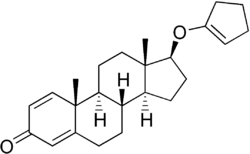Quinbolone
 | |
| Clinical data | |
|---|---|
| Pregnancy category |
|
| Routes of administration | Oral |
| ATC code | A14AA06 (WHO) |
| Legal status | |
| Legal status |
|
| Pharmacokinetic data | |
| Bioavailability | ? |
| Metabolism | hepatic |
| Biological half-life | ? days |
| Excretion | Renal |
| Identifiers | |
| |
| CAS Number |
2487-63-0 |
| PubChem (CID) | 10360683 |
| ChemSpider |
8536132 |
| UNII |
W59598KWLX |
| KEGG |
D05674 |
| Chemical and physical data | |
| Formula | C24H32O2 |
| Molar mass | 352.5156 g/mol |
| 3D model (Jmol) | Interactive image |
| |
| |
| | |
Quinbolone (brand name Anabolicum Vister) is an anabolic-androgenic steroid (AAS). It was developed by Parke-Davis in an attempt to create a viable orally-administered anabolic steroid with little or no liver toxicity.
Quinbolone is a derivative of boldenone with an easily removed cyclopentenyl ether group.
Most orally administered anabolic steroids function by having an alkylated 17α-carbon atom, which prevents first-pass metabolism by the liver. This approach does, however, give the drug a high hepatotoxicity. Quinbolone is not 17α-alkylated; instead it has increased oral bioavailability due to its cyclopentenyl ether group. After ingestion, the inactive quinbolone becomes boldenone.
Quinbolone itself has very few androgenic effects, and most of what it does have are a result of its conversion to boldenone and its metabolites. Because of high doses necessary for androgenic effects, cost and inconvenience meant that quinbolone never proved to be commercially successful, and its clinical applications were fulfilled by alternative, more effective, steroids. Its illicit usage in bodybuilding and athletics likewise proved limited, though drug tests are still used to detect its metabolites as it remains a banned substance for most competitive sports.
Synthesis
Quinbolone can be prepared from testosterone. Dehydrogenation using DDQ forms boldenone. Reaction with 1,1-dimethoxycyclopentane followed by heating to eliminate methanol gives quinbolone.

See also
References
- ↑ Ercoli et al., Chem. Ind. (London) 1962, 1284.